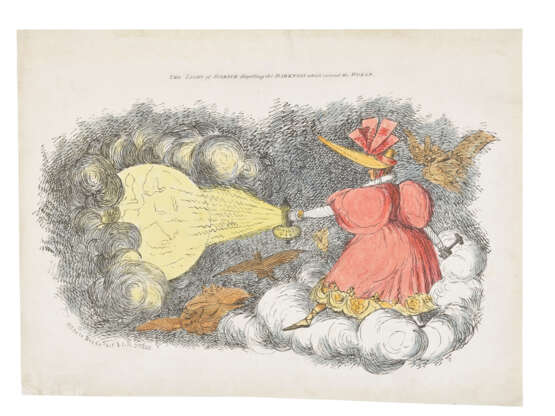DE LA BECHE, Henry (1796-1855)
10.12.2025 12:00UTC +00:00
Classic
Zum Bieten geht es auf die Webseite
CHRISTIE'S| Auctioneer | CHRISTIE'S |
|---|---|
| Veranstaltungsort | Vereinigtes Königreich, London |
| Aufgeld | see on Website% |
ID 1514344
Los 103 | DE LA BECHE, Henry (1796-1855)
Schätzwert
4000GBP £ 4 000 – 6 000
'The Light of Science dispelling the Darkness which covered the World'. 1832.
A celebration of 19th-century women in science: unique hand-coloured example of an important lithograph by the esteemed geologist Sir Henry de la Beche. We are aware of uncoloured examples at the Natural History Museum and the National Library of New Zealand; we are unable to trace any example at auction.
Sir Henry de la Beche was a Fellow of the Royal Society, the first President of the Palaeontographical Society, and the first director of the Geological Survey of Great Britain. He was introduced to the pleasures of palaeontology in the coastal town of Lyme Regis, where he grew up alongside Mary Anning with whom he would go fossil hunting.
The present lithograph was based on an earlier sketch by de La Beche produced in 1825. Much of the depiction remains unchanged between the two; in both, a woman seems to blast away a layer of black clouds which surround the Earth by the light of her lamp. The clothes which the figure wears have been updated to keep pace with the times, particularly noticeable in the adjustments to the sleeve (which benefitted from distinctly more volume by 1832). Also significant is de la Beche’s inclusion of 5 bat-like creatures which soar around the figure, and the clearer depiction of the geologist’s hammer in her other hand. It is an image distinctly tied to its particular time and place; from the female figure's scrupulously up-to-date clothing to the portable gas lamp in her hand, this is a woman of 1832. De la Beche captures the difficult position of female scientists in the period, largely excluded from formal scientific discourse, and yet often making significant contributions to the field.
The identity of this female figure is not known beyond doubt – and it is possible that she stands in a general way as a representative of women’s role in science education at that time – but a pencil annotation on the verso of the copy at the Natural History Museum suggests it might specifically portray the geologist Lady Charlotte Murchison. In 1832, Murchison was one of a trailblazing group of women who insisted on being allowed to attend lectures given by the geologist, Charles Lyell, at King's College, London. Other evidence recommends Mary Anning as a prime candidate: she had close personal ties with the artist, and indeed her discovery of the Pterodactylus in 1828 may have provided ample inspiration for the flying creatures. William Buckland (1784-1856) wrote that the Pterodactylus ‘somewhat resembled our modern bats and vampyres [sic]’ (W. Buckland, ‘On the discovery of coprolites, or fossil faeces in the lias at Lyme Regis [. . .]’, Transactions of the Geological Society of London, 1829, 229).
Hand-coloured lithograph on paper (252 x 345mm). (The whole reinforced, restoring minor fraying to the lower left margin, with considerate repairs to two tears; one in the centre of the upper margin, extending into the printed area; and in the upper of the right blank margin. Minor discolouration from previous framing.)
19th Century
| Herkunftsort: | Nordeuropa, Europa, Vereinigtes Königreich |
|---|---|
| Kategorie des Auktionshauses: | Gemälde, Aquarelle, Zeichnungen, Druckgrafik & Multiples |
| Herkunftsort: | Nordeuropa, Europa, Vereinigtes Königreich |
|---|---|
| Kategorie des Auktionshauses: | Gemälde, Aquarelle, Zeichnungen, Druckgrafik & Multiples |
| Adresse der Versteigerung |
CHRISTIE'S 8 King Street, St. James's SW1Y 6QT London Vereinigtes Königreich | |
|---|---|---|
| Vorschau |
| |
| Telefon | +44 (0)20 7839 9060 | |
| Aufgeld | see on Website | |
| Nutzungsbedingungen | Nutzungsbedingungen |


